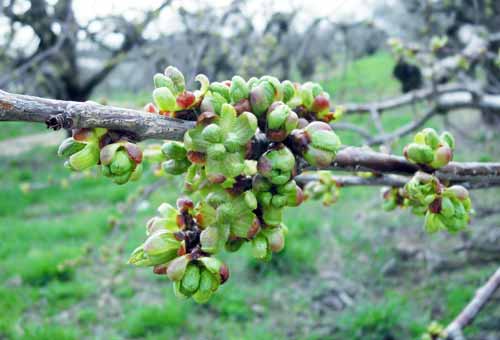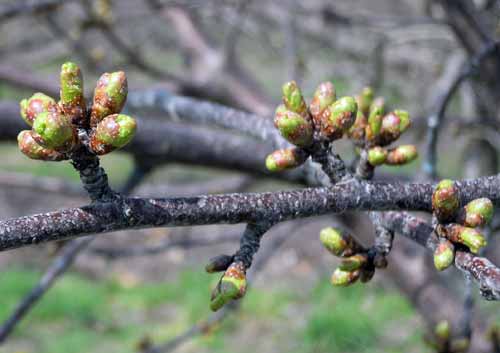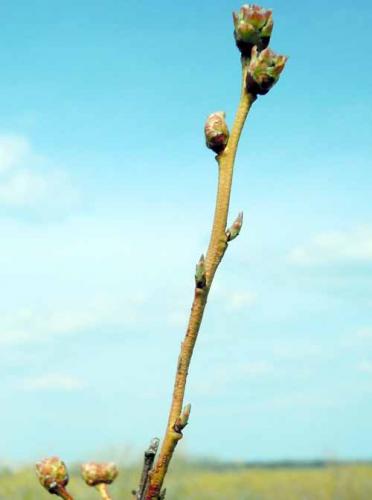Southwest Michigan fruit regional report – April 30, 2013
The first real spring weather accelerates plant growth. Rains can bring disease infections in the southwest.
Weather
This week will be warmer with highs in the 70s and lows well above freezing. There is a good chance of rain showers this week. Now that green tissue is exposed, diseases are a risk and Michigan State University Extension suggests growers apply protective fungicides. Lots of green tissue is out as plants developed quickly in last week’s warm weather.
Last week’s highs were in the 60s. The passage of a cold front on Tuesday (April 23) dropped highs into the 40s with lows around freezing on Wednesday, Thursday and Friday (April 24-26). Friday morning was the coldest with lows in the upper 20s in low laying areas. Little damage from these freezes was reported.
Much warmer temperatures returned Friday and plant growth has been rapid since then. We are now only about a week to 10 days behind normal plant development. We can expect bloom to be about a week behind normal. (See the MSU Extension article “2013 bloom dates for southwest Michigan tree fruit crops.”) At bloom, temperatures just below freezing can kill the blossoms (see “Freeze damage depends on tree fruit stage of development”).
We are about half-way through the freeze season or the period in time when freezing temperatures are likely (see “The probability of a freeze in the spring in Southwest Michigan”). Soils are still wet and some areas have standing water in the fields. Check your local Enviro-weather station and conditions.
Southwest Michigan GDD summary from January 1 to April 28 |
|||
|
Station |
GDD 42 F |
GDD 45 F |
GDD 50 F |
|
Benton Harbor (SWMREC) |
189 |
132 |
67 |
|
Fennville (TNRC) |
144 |
97 |
46 |
|
Average for the region |
182 |
126 |
62 |
|
Regional ten year average |
373 |
286 |
178 |
Tree fruit
Tree fruit are moving rapidly. Southern and central Berrien County is noticeably ahead of northern Berrien and Van Buren counties. Growers are hurrying to get on pre-bloom sprays. Stone fruit flower buds are opening and will need brown rot controls as trees go into bloom.
Apricot bloom has begun in Berrien County.
Peach blooms are opening on the showy varieties in southern Berrien County. A few varieties have light fruit bud numbers, perhaps due to drought stress during bud set last summer and the loss of weakened buds due to winter cold. Otherwise, fruit bud numbers are very high this year, following last year’s light crop.
Copper applications can suppress bacterial spot. The copper reduces bacterial populations that will damage leaves and fruit after bloom. See “Management of bacterial spot on peaches and nectarines” for more details. Be careful to not over-apply copper. Reapplication of copper is not needed until significant amounts have been removed by rainfall.
In cherries, sweet cherries are at bud burst and are showing first white on southern sandy sites. More damage has been reported from the freeze on April 21, with brown and dead pistils in tart and sweet cherry flowers, mostly in the southern end of the southwest district. It will be easier to assess the extent of the damage as flowers open up in a few days.

Sweet cherry buds have burst, exposing the flower buds.
Photo credit: Mark Longstroth, MSU Extension
Tart cherry buds are at green side and not yet open.

A protective copper spray can be seen on these tart cherry buds at green side that will open this week.
Photo credit: Mark Longstroth, MSU Extension
In plums, Japanese plum flower buds are at early bloom for sandy sites in southern Berrien County. Low rates of copper can help suppress bacterial spot symptoms after bloom. Black knot infections occur from first green tissue until active shoot growth slows in early to mid-summer. The most important fungicide treatment time for this disease is from first white on flower buds until about three weeks later. European fruit buds are at tight cluster.
Apples range from 0.5 inches green to tight cluster in Berrien County. In Van Buren County, apples are generally at tight cluster. The rain on Sunday (April 28) was a scab infection period for only some sites in the region. Obliquebanded leafroller are expected to resume activity now after overwintering as larvae. They first feed on water sprouts and then move throughout the tree.
Pear buds are at tight cluster, but not quite at white bud. Pear psylla management begins at the white bud stage.
Small fruit
Growth in grapes has accelerated with warmer weather. ‘Concord’ and ‘Niagara’ are at early bud swell. ‘Marquette’ and Muscat grapes at Southwest Michigan Research and Extension Center (SWMREC) are beginning to show color in the buds, while other wine grapes range from dormant to early swell. There is still a little time to make a delayed dormant application of lime sulfur, sulfur or copper to reduce inoculum of phomopsis, anthracnose, black rot, powdery and downy mildew (see “There is still time for dormant sprays in grapes”). This may be of benefit to growers whose vineyards developed problems with these diseases last year under minimal fungicide application regimes. Check in the 2013 Michigan Grape Management Guide (E-154) to determine whether or not the grape varieties you are spraying are sensitive to copper or sulfur.
We found the first grape flea beetle today walking leisurely over the buds of ‘Marquette,’ but no feeding injury was apparent. Check your vineyard for grape flea beetle activity within the next week or so. As buds continue to develop, climbing cutworms and grape flea beetles are the insect pests of interest. Pre-emergence herbicides should be applied now. Check the 2013 Michigan Fruit Management Guide (E-154) for recommended herbicide products. For more information on cutworms and flea beetles, see “Bud swell is time to monitor vineyards for cutworms and flea beetles.”
In blueberries, flower buds of early varieties are beginning to open. Green leaf tissue is out in Berrien County and in the early varieties in most other areas. As leaf tissue emerges, mummy berry infections are possible. The rainy weather forecast looks ideal for mummy berry. Growers should be scouting for mummy berry apothecia, also called mushrooms or trumpets (see “Scouting and management of mummy berry in blueberries”).
Mummies have been found in wet sites and spore release has begun. Several sizes of mushrooms have been reported and wet flooded fields will have trumpets emerging as they dry out. Spores are generally released under dry conditions, not during rains. Free water is required for the spores to germinate and begin infection. See “Understanding mummy berry shoot strikes” for more information on the infection conditions necessary for mummy berry shoot strike, including the temperature and wetness requirements for shoot infection. See the 2013 Michigan Fruit Management Guide for more information on fungicide sprays for mummy berry control.

A quarter-inch of green leaf tissue means these blueberry shoots need to be protected from mummy berry.
Photo credit: Mark Longstroth, MSU Extension
In strawberries new leaves are emerging from the crown, but flower trusses are not visible. We are watching for strawberry bud weevil (clipper) and tarnished plant bugs as flower buds emerge. Everbearing strawberries in the high tunnels are growing well and more varieties have open flowers than last week.
Bramble buds are moving with 0.25 to 0.5 inches of green tissue out. New primocanes are beginning to emerge from the ground. Fall-bearing raspberries have been mowed. Lime sulfur treatments for anthracnose are being applied. High-tunnel raspberries are more advanced than raspberries in the field.
Upcoming meetings
The next MSU Extension Monday fruit IPM meeting is May 6 at Fruit Acres Farms at 5 p.m. These weekly meetings are good for one RUP credit and will continue through the end of June.
The next Grape IPM meeting is May 22 from 6 to 8 p.m. at Cronenwett Farms, 70121 28th St., Lawton, MI 49065 (view map). See “Dates set for 2013 southwest Michigan grape meetings” for more information on the meetings and how to register.
The second in a series of grape and wine webinars will be held on May 1 from 1:30 to 2:30 p.m. The webinars are free, but you must register for them separately in advance. Register now for “Understanding Michigan's tasting room visitors.” Registration deadline is April 30 at 5 p.m. A web link and instructions will be sent to registrants prior to each event. Each speaker will answer your questions live, time permitting.



 Print
Print Email
Email


